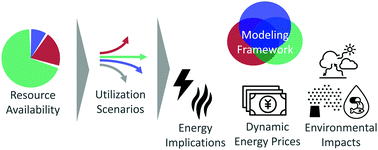Should residual biomass be used for fuels, power and heat, or materials? Assessing costs and environmental impacts for China in 2035†‡
Abstract
Limiting global temperature changes under 2 °C in comparison to pre-industrial levels has been shown as crucial to sustain life on Earth; a central implication being to mitigate greenhouse gas emissions. Residual biomass is a valuable resource, that can replace greenhouse gas intensive fossil fuels. This study assesses large-scale scenarios for utilizing crop and forestry residues, animal manure, food waste, and sewage sludge from a system perspective, and simulates impacts to interrelated electricity and heating systems. The scenarios cover production of biofuels, electricity and heat, as well as materials and feed. Dynamic energy prices and marginal emissions are based on modeling the Chinese energy system towards 2035 in a partial equilibrium linear optimization model, optimizing investments and operation as well as electricity trade and transmission between regions. The resulting marginal emissions and system costs quantify impacts specific to the modeled Chinese energy system in 2035. Scenario costs are assessed including monetization of environmental impacts which were addressed based on a life cycle approach to reflect impacts on global warming, air pollution, marine- and freshwater eutrophication. The study finds that there are major benefits to utilizing residual biomass in all impact categories. Nitrogen leaching was found to pose the largest economic impact. The study furthermore shows that when comparing the climate impact of biomass use scenarios, it is important to include biogenic carbon as well as case-specific marginal emissions.



 Please wait while we load your content...
Please wait while we load your content...